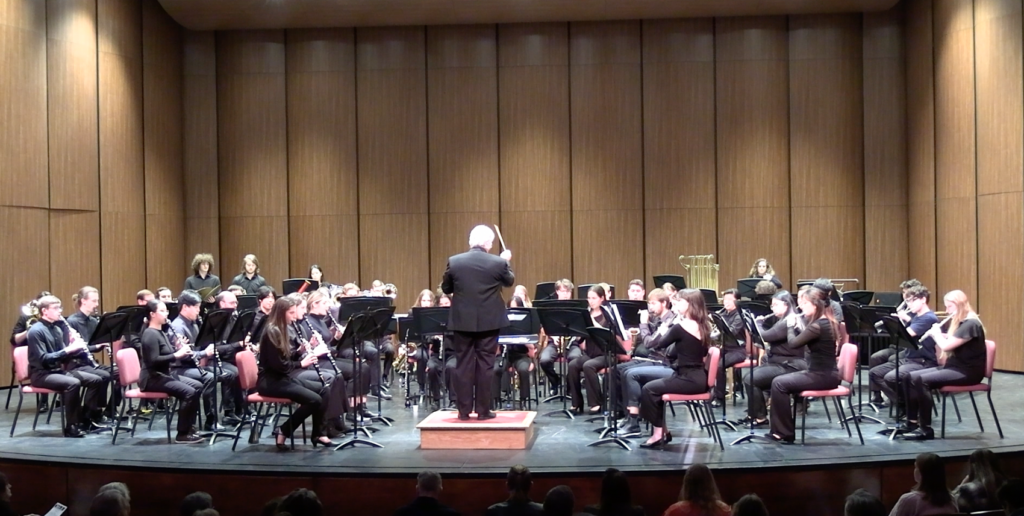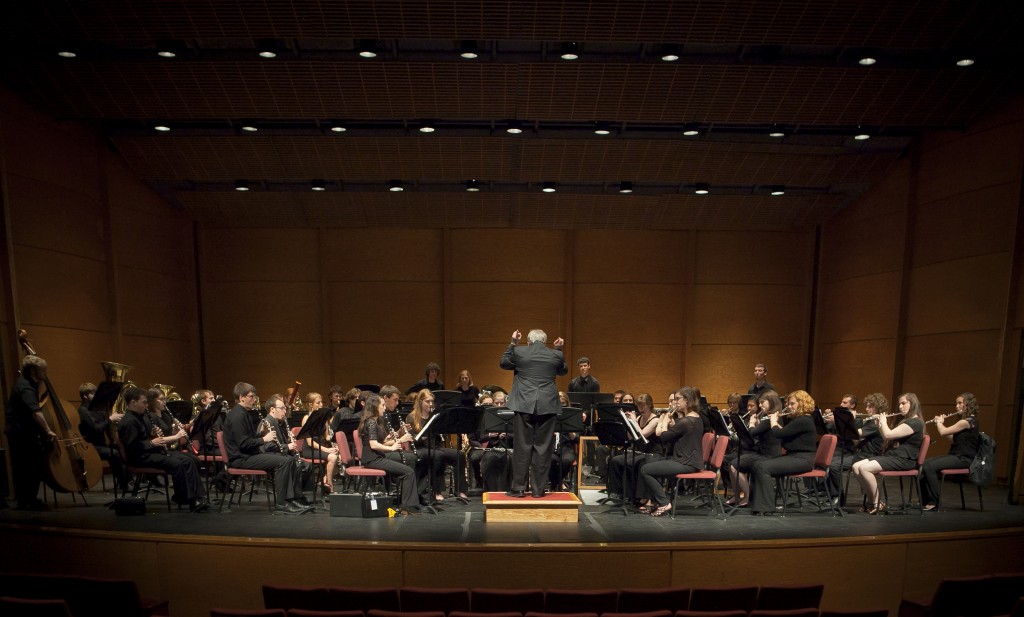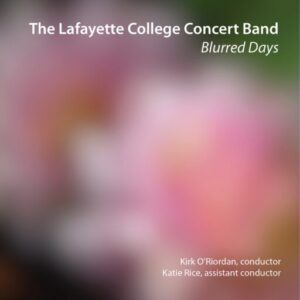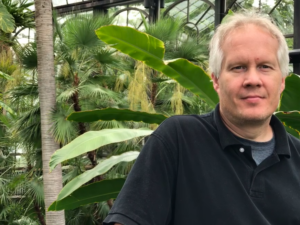Saturday May 10, 2025
Williams Center for the Arts
8:00 pm
Program
English Folk Song Suite (1923)
Ralph Vaughn Williams (1872-1958)
I. March “Seventeen Come Sunday”
II. Intermezzo “My Bonny Boy”
III. March “Folksongs from Somerset”
Soloists:
Corey Stein, trumpet
Emily Rice, clarinet
The Trombone section
One of the cornerstone works in the band repertoire, Vaughn Williams’s work is one of the earliest “serious” pieces for the medium. The three-movement suite is comprised of a series of folk songs from the Norfolk and Somerset regions of Britain, including Seventeen Come Sunday, Pretty Caroline, Dives and Lazarus, My Bonny Boy, Green Bushes, Blow Away the Morning Dew, High Germany, and The Tree So High. The outer movements are set in a March style, while the second movement surrounds a Renaissance-style dance with a lyrical, melancholy melody first presented by the oboe.
Nocturne (2021)
Zhou Tian (b. 1981)
Samantha Semsel ’25, conductor
Soloists:
Brian Morris, flute
Julia Sealing, saxophone
Aram Ramsay, clarinet
Nocturne is a chorale for wind ensemble conceived on a cold, winter night. Lyrical and reflective, the music carries a strong sense of romanticism, and strives to convey a sense of spiritual bliss. The piece was originally written as the middle movement of my first string quartet. My sincere thanks to David Thornton, who initiated this version for wind ensemble with an excellent transcription. I made further arrangements and composed new materials for the current version.
Conductor’s note:
Zhou Tian’s Nocturne allowed me to emotionally connect with a lot of emotions that I have built up for a very long time. This piece in all of its emotional glory allowed me to pour a lot of those emotions and alchemize it into something incredibly beautiful…it is so delicate yet heavy at the same time. It feels like the perfect piece to close an incredibly emotional journey that is college and life. I’m so lucky that I am able to work with this amazing group of people that love the craft and put their emotions into the music as well. I love LCCB for it’s amazing ability to feel the music, they always put their souls into this concert every semester, and I’m so happy that I get to work with the band this way.
a deep reverberation fills with stars (2002)
John Mackey (1898 – 1932)
Soloists:
Anastaisa Krial-Victor, trumpet
Aram Ramsay, clarinet
Daniel Ruggiero, piano
The Percussion Section
“This is the most substantial piece I’ve written since the start of the pandemic. I’d written very little; it was basically impossible for me to motivate myself when concerts grinded to a halt. So the idea with this one—partially by design, but largely just because it happened to turn out this way once I started writing—is that of emerging from darkness (“a deep reverberation”) with the return of some sense of normalcy, coinciding with—at least for me—some hope of an improvement of mental health.”
–John Mackey
–Intermission–
Folk Dances (1942)
Dimitri Shostakovich (1906 – 1975)
Folk Dances is a standard repertoire piece for wind bands, but Shostakovich may never have heard it played by a band. It came to the United States in a 1979 edition by H. Robert Reynolds, which remains the standard version today. The previous version was for Russian bands, arranged by Mark Vakhutinskii in 1970. Shostakovich’s original was the third movement of his 1942 suite of incidental music for a musical revue called The Motherland, also known as My Native Leningrad or Otchizna, his opus 63. The suite, written during the bleakest days of World War II, was often somber, ending with a hymn to Leningrad for orchestra and choir. The source material of Folk Dances was the “Dance of Youth,” a purely instrumental movement intended, it seems, to lighten the suite. It includes several Russian folk melodies strung together one after the other as it accelerates to a big finish. It is worth noting that the revue was originally performed by the Song and Dance Ensemble of the NKVD, the Soviet Union’s feared secret police that later became the KGB.
Notes by Andy Pease (Wind Band Literature)
Music for Prague 1968 (1968)
Karel Husa (1921 – 2016)
I. Introduction and Fanfare
II. Aria
III. Interlude
IV. Toccata and Chorale
Soloists:
Brian Morris, piccolo
Emily Kozero, flute
Aram Ramsay, clarinet
Will Hoelzel, snare drum and timpani
The Trumpet Section
The Percussion Section
Three main ideas bind the composition together. The first and most important is an old Hussite war song from the 15th century, “Ye Warriors of God and His Law,” a symbol of resistance and hope for hundreds of years, whenever fate lay heavy on the Czech nation. It has been utilized by many Czech composers, including Smetana in My Country. The beginning of this religious song is announced very softly in the first movement by the timpani and concludes in a strong unison (Chorale). The song is never used in its entirety.
The second idea is the sound of bells throughout; Prague, also named the City of “Hundreds if Towers,” has used its magnificently sounding church bells as calls of distress as well as of victory.
The last idea is a motif of three chords first appearing very softly under the piccolo solo at the beginning of the piece, in flutes, clarinets and horns. Later it reappears at extremely strong dynamic levels, for example, in the middle of the Aria.
Different techniques of composing as well as orchestrating have been used in Music for Prague 1968 and some new sounds explored, such as the percussion section in the Interlude, the ending of the work, etc. Much symbolism also appears: in addition to the distress calls in the first movement (Fanfares), the unbroken hope of the Hussite song, sound of bells, or the tragedy (Aria), there is also the bird call at the beginning (piccolo solo), symbol of liberty which the City of Prague has seen only for moments during its thousand years of existence.
Notes by Karel Husa
Karel Husa’s Music for Prague 1968 was commissioned by the Ithaca College Concert Band and composed during the summer and fall of 1968 for the capital city of Czechoslovakia. The work was premiered by the commissioning ensemble in Washington, D.C., on January 31, 1969, Dr. Kenneth Snapp conducting, in a concert for the Music Educators National Conference.
From the Conductor
With your indulgence, I’d like to take a moment to share a few thoughts on this semester, our repertoire, and on the family that is The Lafayette College Concert Band. I’ll say a bit of this during the performance, but I don’t want to leave anything out. And I am not ashamed to say that I will have a difficult time getting through this on stage tonight, so I thought I would do this here.
It is always a profound joy to work with these amazing students, and more so this semester. Their focus, work ethic, camaraderie, and dedication to the pursuit of excellence has inspired and sustained me. One example of this is how they approached Music for Prague. This is a challenging work…physically, yes, but more so emotionally and intellectually. From day one they embraced the difficult harmonic language and threw themselves with abandon into the task of metabolizing it in a way that allows you to hear what Karel Husa needed to say. They put their heads down and did the work–every day, without complaint and always with enthusiasm and a genuine love for what they were doing.
I am incredibly grateful for how they embraced Sam and all of our student conductors throughout the years. Conductors can learn the choreography of beat patterns pretty quickly…but the only way they can truly learn how to lead other human players toward an expressive performance is learn how their physical gestures turn into sound. It takes a great deal of patience as a player to give a student conductor the time they need to figure that out. They have given Sam the same focus and commitment they give me, and I have felt that they have been personally invested in Sam’s success all semester.
The kind of mutual support, indeed the kind of community we have in this band doesn’t come without incredible student leadership. It is in the end their band, and like with Sam, they are invested in each other’s success. Our seniors inherited a post-pandemic rebuilding project and have reshaped the band’s culture in a way that has allowed us to grow well beyond where we were when we shut down in March 2020. They have been remarkable, and have indeed set a high bar for our Juniors.
I have been extremely fortunate to have had leaders in this band who care as much about the band and its people as I do; people who know when something needs to be done; who get it done right, the first time and every time; who earned the respect of their peers because they have integrity, dedication, skill, and because they honestly and unashamedly live the example they wish to set. For the past four years the person that has most exemplified this leadership has been Emily Rice. I cannot adequately express my gratitude to her and to her family for their indescribable dedication to and support of me and the Lafayette Band program.
This band lives together, studies together, and eats together after rehearsals. On stage tonight we have two parents of current band students, and one married couple who met in Concert Band. We have four advanced high school students playing with us, and three of them will be members of the Lafayette Class of 2029. We have six LCCB alumni joining us as well. We are a family…we play to give our Seniors one last great concert; to give our First-years a welcoming experience and to teach them that their potential is much greater than they think it is. We play to enable and empower the Juniors, who will assume the mantle of leadership next year, and to prepare the Sophomores, because their time is coming sooner than they realize.
We play because we love Music and what it teaches us about being leaders, teammates, professionals, and human beings. We play because good music challenges us to connect with humanity in meaningful ways. Music is inseparable from who we are as people, whether we are engineers, biologists, historians, economists, or teachers. What we all experience tonight will be a part of us as long as we live.
The Lafayette College Concert Band
Assistant Conductor
Samantha Semsel
—–
Flute
Brian Morris, Principal
Emily Kozero
Samantha Semsel, Associate Principal
Emma Martin
Iris Peluso
Lauren Kaye
Madison Galluzzo***
Oboe
Olivia Bamford
Clarinet
Emily Rice (Principal)
Aram Ramsay
Priscilla Wu
David Broczkowski
Lily Hoogius
Ashley Kushner-Kmetz
Sungbum Lee (Military Service, 2024-26)
Will Cassidy
Christopher Ruebeck
Jennifer Blair
Bass Clarinet
Benjamin Alter
Bassoon
Sean Catarroja
Peter Rice
Saxophone
Julia Sealing (alto, soprano), Principal
Cassidy Baisley (alto)
Andrew Manni (alto)
Alex Kmetz (alto)
Chloe Williams (tenor), Associate Principal
Katie Rice (tenor)
Elisa Massa (baritone)
Horn
Madeline Paguia, Principal
Sophie Cron
Nicholas Pignolo
Trumpet
William Blair
Corey Stein
Anastasia Krial-Victor
Drew Borek
Tyler Grogg
Charlotte Konopada
Trombone
Pedro dos Santos (Low Brass Principal)
Jackson Eshbaugh
Benjamin Zwicker
Jasmine Smith
Bass Trombone
Christopher Taverner
Tuba
Ryan Pignotti
Jack Kerekes
Mikayla Vangelo
Piano
Daniel Ruggiero
Percussion
Will Hoelzel
Casey Alexander
Joe Freeston
Noam Raich
Henry Schrader
Graduating Seniors
Lafayette Faculty/Staff
LCCB Alumni
Guest Performers
 The Lafayette College Concert Band is comprised of approximately 50 students, faculty and alumni from a variety of majors who are united by a strong desire to perform the highest quality music at the height of their abilities. Participation in LCCB is open to students in any major as well as faculty and staff. The ensemble is conducted by Kirk O’Riordan, Associate Professor of Music.
The Lafayette College Concert Band is comprised of approximately 50 students, faculty and alumni from a variety of majors who are united by a strong desire to perform the highest quality music at the height of their abilities. Participation in LCCB is open to students in any major as well as faculty and staff. The ensemble is conducted by Kirk O’Riordan, Associate Professor of Music.
LCCB typically performs one concert each semester. The repertoire is selected from traditional concert band masterpieces, newer works by established and emerging composers, commissions, and orchestral transcriptions. Past concerts have included works such as Husa’s Music for Prague 1968, Bernstein’s Symphonic Dances from West Side Story, both Holst Suites, Grainger’s Lincolnshire Posy, and Mussorgsky’s Pictures at an Exhibition. LCCB has premiered works by composer/conductor Kirk O’Riordan and 2010 Pesky Artist in Residence William Pfaff as well as Ashley Kushner ’19 and Zach Jones ’13.
Students enroll for 1/4-credit. Open to all students, faculty and staff, LCCB employs a wind ensemble model for instrumentation. A seating audition is required before the first semester of participation. Due to the large numbers of flutists, clarinetists, saxophonists, and trumpeters, the number of available seats in these sections may be limited.
 Several opportunities for leadership in the ensemble are available for highly motivated, experienced players. Principals in each section lead sectional rehearsals and help the less experienced players with technical issues. The Assistant Conductor is a highly advanced musician who has been studying conducting for at least one year prior to serving in the position. She/he conducts the ensemble on at least one piece in performance, having led all the rehearsals for that performance. Typically, that person also leads Pep Band and conducts the annual Marquis Players musical production. Finally, the LCCB President is nominated and elected by the student membership of the ensemble. This person works with the director and the Assistant Conductor on administrative tasks as a representative of the students.
Several opportunities for leadership in the ensemble are available for highly motivated, experienced players. Principals in each section lead sectional rehearsals and help the less experienced players with technical issues. The Assistant Conductor is a highly advanced musician who has been studying conducting for at least one year prior to serving in the position. She/he conducts the ensemble on at least one piece in performance, having led all the rehearsals for that performance. Typically, that person also leads Pep Band and conducts the annual Marquis Players musical production. Finally, the LCCB President is nominated and elected by the student membership of the ensemble. This person works with the director and the Assistant Conductor on administrative tasks as a representative of the students.
Blurred Days CD
 Like many bands and other performing ensembles across the country, we have had to adapt to the pandemic. For us, this has meant that we have not been able to work together, in person. This has always been a band that thrives on its sense of community, and not having that has been hard on all of us.
Like many bands and other performing ensembles across the country, we have had to adapt to the pandemic. For us, this has meant that we have not been able to work together, in person. This has always been a band that thrives on its sense of community, and not having that has been hard on all of us.
But rather than mourn what we have lost, we have searched for opportunities within our remote format that are unique. Working in isolation has allowed us to re-examine the possibilities of the Wind Ensemble as an entity—to re-imagine what is possible with this collection of sounds.
The five pieces on this CD were written especially for us, and especially for our situation. Each of the pieces was conceived to take advantage of techniques that would not be possible in a traditional concert—effects on a person-by-person level, or writing for flutes in their lowest register.
To make these performances, each student recorded his or her part on their phones or computers and uploaded them to either a shared drive or to the web-based recording service Band Lab. Katie Rice assembled the tracks and performed the first round of editing. I took the tracks she finished and combined them into the final product, completing the pre-production audio work.
Every student has a unique track in the recording, which allows us to use studio effects on a person-by-person level. With many of the pieces, the individual parts were created to be non-linear—we could create specific sonic effects and duplicate them in the recording software. Several of the pieces incorporate improvisation, narration, and other unconventional techniques.
Kirk O’Riordan, Conductor
 Kirk O’Riordan’s music has been referred to as “unapologetically beautiful” and is often praised for its uniquely “visual” qualities that depict a wide range of striking moods. His debut compact disk, Strange Flowers, was released by Ravello Records in November, 2013 and was praised by Audiophile Audition as “one of the most impressive and beautiful collections of chamber music I have heard in awhile….This is all just so lovely and invokes exactly the emotions that good music should be able to induce in all of us.” Gramophone Magazine praised O’Riordan as “a composer for whom imagery is a defining inspiration….[he] is a deeply sensitive composer who savours going gently into the night.” (April 2014).
Kirk O’Riordan’s music has been referred to as “unapologetically beautiful” and is often praised for its uniquely “visual” qualities that depict a wide range of striking moods. His debut compact disk, Strange Flowers, was released by Ravello Records in November, 2013 and was praised by Audiophile Audition as “one of the most impressive and beautiful collections of chamber music I have heard in awhile….This is all just so lovely and invokes exactly the emotions that good music should be able to induce in all of us.” Gramophone Magazine praised O’Riordan as “a composer for whom imagery is a defining inspiration….[he] is a deeply sensitive composer who savours going gently into the night.” (April 2014).
His recording of his Twenty-Six Preludes for Solo Piano—by pianist Holly Roadfeldt—has attracted similar praise: “are similarly atmospheric and proceed to unfold like a magical tapestry. Each of the 26 Preludes seemingly comprising of warp and weft forming a myriad of pixels of little pictures that ultimately combines to form a moveable feast for both eye and inner ear. O’Riordan’s miniatures are informed by languorous beauty and profundity, the lyrical variations of each often feature elaborate embellishments, as well as sudden dissonant figurations that seem to mimic the gravity-defying leaps of the gazelle…” (World Music Report, April 2017).
O’Riordan (b. 1968) is an active composer, conductor, saxophonist, and teacher. His music has been performed in Canada, China, Costa Rica, Cyprus, Finland, Italy, and Russia; and in thirty of the fifty United States. Performances of his works have been featured at the Ravenna Festival (Italy), the Indiana State University, University of North Carolina, Greensboro and Western Illinois New Music Festivals, the 2008 Eugene Rousseau Birthday Celebration, national and regional conferences of the Society of Composers, Inc. and the College Music Society; and in concert by such performers as the Eaken Piano Trio, Tresillo, The Moran Woodwind Quintet, Orchestra Bruno Maderna (Italy), the Arizona State University Chamber Winds and Symphony Orchestra, the Northwestern University Contemporary Music Ensemble, the Cleveland State University Orchestra, the University of Colorado Chamber Wind Ensemble, the University of Delaware University Singers, the Williamsport Chamber Chorus and Orchestra, the Susquehanna University Orchestra and Chamber Singers, The Lafayette College Concert Band, Contemporary Music Ensemble, and Percussion Ensemble, the SKIN Ensemble, Frederick Hemke, Timothy McAllister, Lawrence Stomberg, Marianne Gythfeldt, Kenneth Tse, Jeffrey Lyman, Emily Bullock, Steven Stusek, Andrew Rammon, Reuben Councill, John Perrine, and Holly Roadfeldt.
Kirk is the recipient of numerous awards as both a composer and a performer, including annual ASCAPlus awards, a Composer’s Assistance Program grant from the American Music Center, the 2001 Arizona State University Composition Competition, the 2000 Contemporary Music Society competition, and an ERM-Media Masterworks Prize. In addition, his Cadenza for Piano Trio was one of two works selected by audience members at the CMS Mid-Atlantic/Northeast Super-regional Conference for performance at the 2008 CMS National Conference.
Kirk’s music has been broadcast on WSMR, KBAQ, WQSU, and WVIA radio. Recordings of his works appear on the Crystal Records, Ravello, Centaur, ERM-Media and EnF labels, and feature performances by Kenneth Tse, Lawrence Stomberg, Marianne Gythfeldt, Holly Roadfeldt, Frederick L. Hemke, The Kiev Philharmonic, and Farrell Vernon. He has recently received commissions from AVIDduo, Saxton Rose, and Holly Roadfeldt. He recently completed his first opera: The Masque of Edgar Allan Poe, a one-act chamber opera based on Poe’s “Masque of the Red Death” on a libretto by Lafayette College colleague Lee Upton. The work was premiered by the University of Delaware Opera Theater in November, 2016 and subsequently at Lafayette College. Other projects have focused on music for dance: his River Lights for Orchestra (as recorded by the Kiev Philharmonic) was used by dancer/choreographer Ben Munisteri in his piece, Robot vs. Mermaid. O’Riordan has also collaborated with dancer/choreographers Carrie Rohman and Nandini Sikand. Recent projects include a concerto for Taiko Ensemble and Concert Band (for the Lafayette College Percussion Ensemble and Concert Band), incidental music for a Lafayette College Department of Theater production of Mary Zimmerman’s play Metamorphosis, and a new work for viola and piano for violist Michael Hall and pianist Holly Roadfeldt.
Dr. O’Riordan joined the faculty of Lafayette College in 2009, and now serves as Associate Professor of Music and Director of Bands, teaching courses in music theory, and composition. In addition, he teaches in the First-year Seminar program and conducts the Lafayette College Concert Band and Contemporary Music Ensemble. During his time at Lafayette, the Concert Band has been hailed for its ambitious and adventurous programming, having performed works such as Husa’s Music for Prague 1968, his own orchestration of Pictures at an Exhibition, and world premieres by O’Riordan, Ashley Kushner, Justin Kogasaka, Zach Jones, Pete Deshler, and William Pfaff. Previously, he served on the faculties of Bucknell University and Susquehanna University where he taught music theory, composition, music appreciation, and (English) writing. He has also served on the faculties of Lock Haven University, Colorado Christian University, Chandler-Gilbert Community College, and Paradise Valley Community College. He holds the Doctor of Musical Arts degree from Arizona State University (the first recipient of that degree from ASU); the Certificate of Performance in Saxophone from Northwestern University; and three Master of Music degrees (composition, saxophone performance, and conducting).
Kirk has studied composition with Rodney Rogers, Randall Shinn, James De Mars, Glenn Hackbarth, Jay Alan Yim, Burton Beerman, Marilyn Shrude, and Donald M. Wilson. He has studied saxophone with Frederick L. Hemke, John Sampen, Eugene Rousseau, and Iwan Roth. In his free time, Kirk is an avid fan of Obstacle Course Racing.